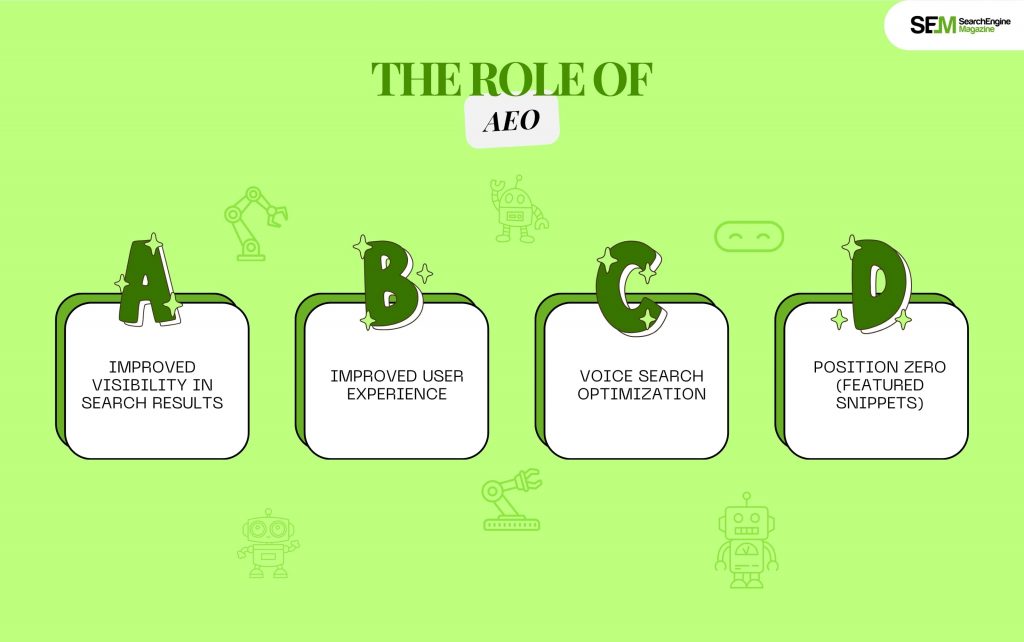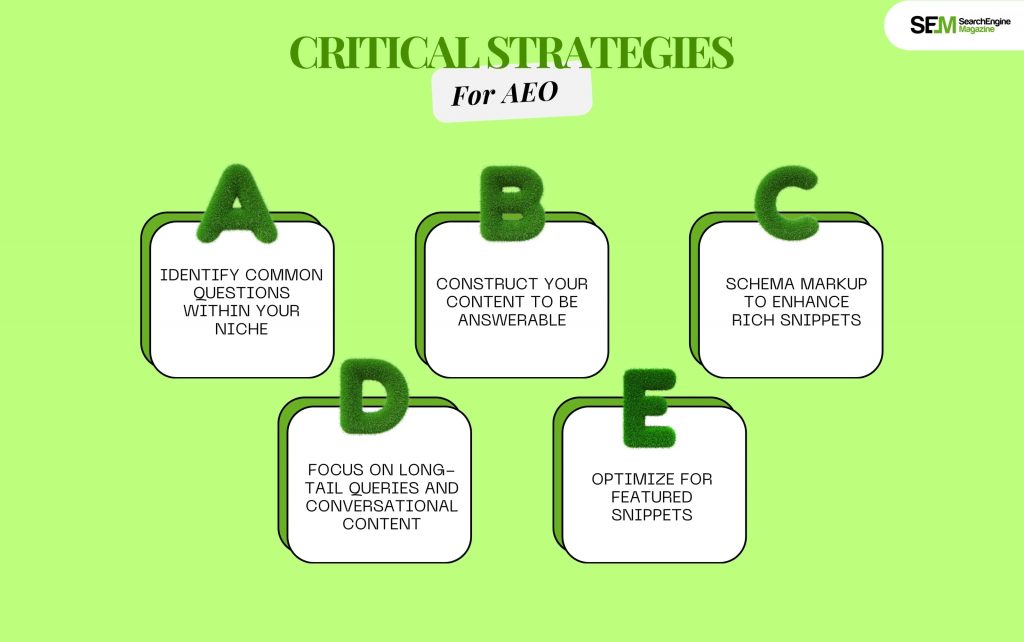How To Know If Someone Blocked You On iMessage? 5 Secret Hacks!
Apr 16, 2025

Apr 16, 2025

Apr 16, 2025

Apr 15, 2025

Apr 11, 2025

Apr 11, 2025

Apr 11, 2025

Apr 08, 2025

Mar 29, 2025
Sorry, but nothing matched your search "". Please try again with some different keywords.


A new frontier has emerged in the never-ending evolutionary landscape of advancing search engine optimization (SEO): Answer Engine Optimization (AEO).
SEO focuses on improving rankings within search engine results pages (SERPs) based on keywords, backlinks, and on-page factors. AEO seeks to answer a far more fundamental question. How can we make content more accessible and relevant for users who expect direct, precise answers?
AEO combines traditional SEO with strategies that provide the most useful, concise, and direct answers to users’ queries. This is because search engines, particularly Google, have been changing towards focusing on answering the query in the form of a knowledge panel, featured snippets, and direct responses rather than just giving a list of relevant web pages.
In this article, we’ll dive deep into the concept of Answer Engine Optimization, exploring its importance and key strategies. And how businesses and content creators can adapt their digital marketing approach to leverage this new model.

Answer Engine Optimization – Optimizing the content to directly answer the search queries. Increasing its chances of becoming a “featured snippet,” knowledge graph result, other types of “instant answers” appearing directly within the results of search engines.
With a world of user behavior trending toward voice search and direct answers, AEO aims to meet that demand for instant, accurate, and accessible information. Search engines, like Google, are trying to evolve from merely indexing and ranking web pages to “answer engines,” providing direct answers on the SERPs.
In a typical example, if you search for a question like “What is the capital of France?” on Google, the search results page would feature the answer “Paris” on the front page, usually in a box called “Knowledge Panel” or “Featured Snippet.”

The advancement of AI, machine learning, and natural language processing (NLP) skills has been instrumental in going from traditional SEO to AEO. Search engines, like Google, have become more competent in understanding the meaning of a user’s query outside of the keyword alone.
For example, the BERT update on Google introduced more complex techniques for understanding nuances of natural language.
With this development, search engines are moving to an intent-based understanding of queries. Results that can answer direct questions. Optimization for keywords is not enough; one needs to anticipate the kinds of answers that your readers seek.

Users expect seamless, immediate, and frictionless answers as the algorithms at their back improve. The core importance of AEO lies in delivering that experience by focusing more on delivering answers rather than links pointing to pages where one might find the answer.
For these reasons alone, AEO is turning out to be critical to modern SEO:
The primary benefit AEO has is the increased visibility of the content. Chances are high that more users will spot your content when it’s a featured snippet or appears under the “People Also Ask” section.
This brings in substantial traffic since users are eager to click on results visible directly on SERPs rather than waiting to land on your website and then search for the same information.
Google’s primary goal is to quickly enhance the user experience by providing the most relevant information. By answering questions directly AEO improves the efficiency of the search process. It allows users to find the information they need without having to navigate through multiple websites.
Given the increasing popularity of voice assistants such as Google Assistant, Siri, and Alexa, voice searches require direct, simple answers. And since voice search is primarily a feature for mobiles, AEO is very mobile-friendly, making it easier for mobile optimization.
Voice queries are usually short, question phrased, often like how a person might ask a question in a normal, conversational context. Optimizing for AEO means your content is more likely to be eligible to appear as a direct answer in the voice search results.
Position Zero, or the featured snippet, is perhaps one of the most coveted positions in search results, even though it gives an instantaneous brief answer at the top of the page with a link back to the source content.
Being in such a spot makes your content more noticeable and increases your site’s authority and relevance. AEO can help content creators maximize their chances of being featured by optimizing for this coveted position.

Do not confuse AEO with SEO. AEO requires attention to those strategies that would best satisfy search engines but should simultaneously clearly deliver answers to users. Below are some critical tactics that can help improve your AEO efforts.
One of the starting steps in AEO is figuring out the kinds of questions users in your niche are asking. Conducting thorough keyword research and digging through “People Also Ask.” It may help identify common queries your target audience is searching for.
From this, you understand the most frequently asked questions, and you can determine how you can directly answer your content.
As the content is well-structured and easy to read, search engines look for it. AEO optimization means structuring your content answerably so users and search engines can easily find and understand the answers to their questions.
Best Practices:
Schema markup is a form of microdata that can help search engines better understand the context of your content. Adding structure to your web pages using schema markups increases the chances of your content showing up as a rich snippet or knowledge panel.
Schema can be used for most types of content, such as:
With conversational AI and voice search becoming increasingly prevalent, users will ask longer, more natural questions. For example, instead of searching for “best camera,” a user might say, “What is the best camera for beginners in 2024?”
Create content that addresses long-tail keywords and questions to optimize for these queries. Create that content by.
Featured snippets are one of the most active direct ways to secure an answer in search results. For better optimization, your content should be clear, concise, and formatted accordingly for featured snippet optimization.
AEO is not a one-time deal. Instead, it is important to observe the results of this work and adjust as necessary. Track your featured snippet rankings, your presence in the knowledge panel. And all other formats of direct answer formatting that you are targeting.
Use tools like Google Search Console and Google Analytics to monitor how your content is performing in search results. Regularly review your keyword strategy and adjust your content to align with user intent and search engine requirements.

With the advancement of AI, NLP, and machine learning, the future of AEO will only integrate itself deeper into the DNA of SEO. Personalized answers combined with relevant context, as toolchains like ChatGPT and Google’s capabilities in AI offer. It will grow more meaningful over time.
The secret to success in the future for AEO will lie in staying ahead of technological revolutions and constantly updating your content to meet what the user wants.
Search engines evolve from the earlier days of indexing and ranking to understanding intent and delivering answers immediately. Businesses embracing AEO have a head start on remaining competitive in the digital space.
Answer engine optimization is the next evolution of SEO. It focuses on providing direct, relevant answers to users’ queries and brings businesses closer to gaining that merit. As the internet becomes increasingly fast, accurate, and satisfying, adopting AEO will be necessary for remaining relevant and competitive online.
Understanding and applying AEO strategies, finding commonly asked questions, and organizing your content for easy understanding. And using schema markup brings your content to the forefront of meeting this ever-growing demand for instant answers. The wave of answer-focused search engines is not a fad; it’s the way of the future.
To succeed in the New Answer Engine Age, think like the answer engine itself. What do you need to produce the most accurate, relevant, and concise information for your audience exactly when they need it most?
You May Like To Read This:
Nabamita Sinha loves to write about lifestyle and pop-culture. In her free time, she loves to watch movies and TV series and experiment with food. Her favorite niche topics are fashion, lifestyle, travel, and gossip content. Her style of writing is creative and quirky.
View all Posts
How To Know If Someone Blocked You On iMessag...
Apr 16, 2025
7 Website Design Mistakes That Are Hurting Yo...
Apr 16, 2025
Programmable Dynamic SEO for Location-Based P...
Apr 15, 2025
Google Boba Game: How To Play This Fun Game B...
Apr 11, 2025
Which Is The Best Video Search Engine Of 2025...
Apr 11, 2025

